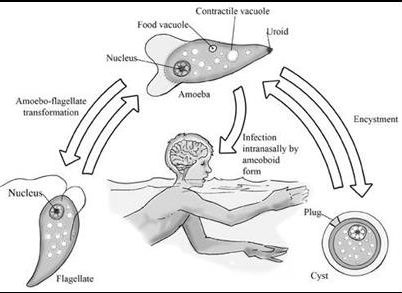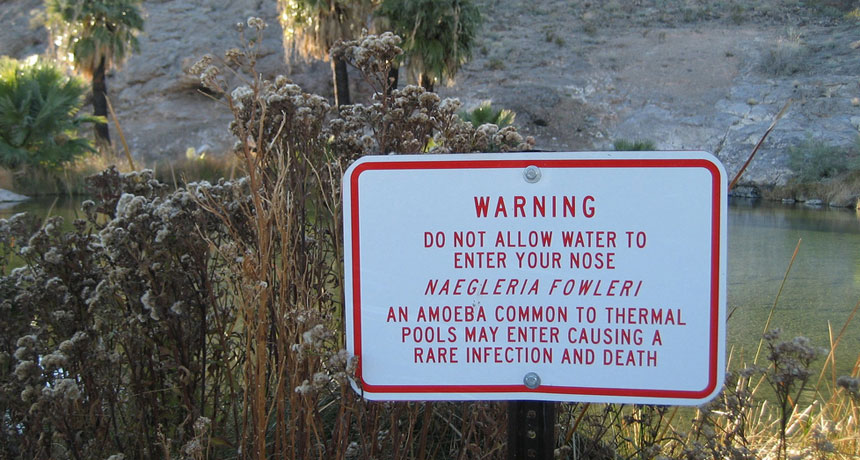A rare amoeba causes a disease with a 98.5% fatality rate. Should we be worried?
It’s a beautiful day for swimming at the lake: the sun is shining, the breeze is blowing, and the water is warm. As far as you can tell, no risks are present. That night, you go to sleep with a mild pain around your sinuses but think nothing of it. The next day, you notice a dulled sense of smell and stiffness in your neck. Over the next five days, your life becomes a living nightmare. Hallucinations, high fevers, and seizures set in (1). You go to the doctors, who perform a spinal tap and biopsy the olfactory bulb through your nose (3). In your cells, they see it: Naegleria fowleri. It’s an amoeba that has begun to eat and multiply in your brain, and in the next week, it will almost certainly kill you. You have a 1.5% chance at survival (3). On the autopsy table, your brain will resemble Swiss cheese. For a few unlucky people every year, this is reality.
N. fowleri is known widely as the “brain-eating amoeba.” It thrives in warm water and reproduces by entering the brain through the nose and feeding on neurons, with the olfactory nerves the first to go. (1). This destruction of brain cells and structures causes the devastating, deadly symptoms of Primary Аmebic Мeningoencephalitis (PAM). There have been around 480 recorded cases, and only 7 survivors (3).
The adaptable life cycle and fast multiplication of the amoeba make it especially dangerous. N. fowleri has one nucleus and a “granular” appearance and reproduces through promitosis, a binary division that leaves each of its nuclear membranes intact. The amoeba has three different stages of life, each suited to different environments and stimuli. It enters the brain in the trophozoite stage of life, during which it is able to feed and reproduce on brain cells, as well as penetrate nasal tissue. The trophozoite stage is the second stage of N. fowleri’s life: the first—the “cyst” stage—only exists while the amoebas are in lakes (1). The third stage, known as the flagellated state, occurs when the amoebas are faced with adverse stimuli, such as the lack of food. This allows them to move more quickly, but not to reproduce or feed (3).

N. fowleri must enter the brain through the nose during the trophozoite stage, and cannot be infectious at any other stage or through any other method. Humans cannot get PAM by drinking infected water; N. Fowleri needs immediate access to the brain through the olfactory system to survive (1). Thus, the presence of N. fowleri in unsafe drinking water is far less dangerous than its presence in recreational swimming areas.
Because of the amoeba’s nasal entry method, the first symptom to develop is often a loss of smell. By the time that happens, though, it is already too late for most treatment. Only seven recorded people have ever survived, and those seven survivors relied on immediate diagnosis and novel, experimental treatments (4). Because of PAM’s extreme rarity and symptomatic similarity to bacterial meningitis, the odds of a fast diagnosis are low. In fact, many cases are only diagnosed post-mortem (3).
PAM is nearly impossible to treat, and just as difficult to prevent. However, individuals and organizations can and should take some measures. In lakes and rivers, water is difficult to make safe. When swimming in lakes, participants should acknowledge the risk of catching N. fowleri and other water-borne illnesses (1).

However, in pools, officials can eliminate risk. Pool water should be chlorinated to kill bacteria and amoebas. Just this September in Texas, a child playing at a public waterpark contracted PAM and died (2). Cities are responsible for ensuring that their water is safely treated: this Texas waterpark was at dangerously low chlorine levels. Just one part-per-million of chlorine will easily kill N. fowleri, and drinking water is safe up until four parts-per-million of chlorine have been added to it. Cities have no excuse not to safely chlorinate water. The Texas case occurred due to employee errors and lack of diligence with testing and maintenance: simple carelessness. Cities can be held liable by victims’ families over cases like this where negligence is a factor (6).
While chlorine kills N. fowleri, warmth does the opposite. In America, the amoeba thrives largely in the warm waters of Texas, Louisiana, and Florida. As water sources heat up, amoebas are able to reproduce and infect humans more easily. Thus, climate change will bring about higher rates of N. fowleri (5).
Currently, there have been no recorded cases of PAM in Massachusetts, as well as none in New England (6). We are safe from N. fowleri while swimming and living here in the north, but this could change as the climate does. We have no need to be worried about N. Fowleri—yet.
Naegleria fowleri is a terrifying amoeba with incredibly fast-moving, destructive abilities. Short of plugging our noses when we swim or avoiding lakes in warm regions, there is nothing we can do on a personal level to prevent us from contracting PAM. On a national level, there is work to be done. Water safety must be a priority, especially in the American South where these amoebas thrive. Finally, N. fowleri has shown itself to be yet another deadly factor of climate change. Brain-eating amoebas may be a significantly lesser threat to us than the threat of government negligence, including inadequate climate legislation.
Bibliography
- Centers for Disease Control and Prevention. (2007). Primary Amebic Meningoencephalitis — Arizona, Florida, and Texas, 2007. Centers for Disease Control and Prevention. Retrieved October 1, 2021, from https://www.cdc.gov/mmwr/preview/mmwrhtml/mm5721a1.htm.
- Jackson, A. (2021, September 28). Child dies after contracting brain-eating amoeba at a texas splash pad. CNN. Retrieved October 1, 2021, from https://www.cnn.com/2021/09/28/us/child-death-brain-eating-amoeba-splash-pad-texas-trnd/index.html.
- Centers for Disease Control and Prevention. (2017, February 28). Primary Amebic Meningoencephalitis (PAM) – Naegleria Fowleri. Centers for Disease Control and Prevention. Retrieved October 1, 2021, from https://www.cdc.gov/parasites/naegleria/index.html.
- Cohen, E. (n.d.). Kali Hardig, brain-eating amoeba survivor, to begin … – CNN. CNN. Retrieved September 30, 2021, from https://www.cnn.com/2013/09/12/health/arkansas-amoeba-survivor/index.html.
- Lippman, D. (2014, February 18). How the spreading symptoms of climate change can be deadly. Scientific American. Retrieved October 2, 2021, from https://www.scientificamerican.com/article/how-the-spreading-symptoms-of-climate-change-can-be-deadly/.
- Naegleria fowleri: Brain-Eating amoeba. ICC. (2020, August 14). Retrieved October 1, 2021, from https://www.iccsafe.org/building-safety-journal/bsj-technical/naegleria-fowleri-brain-eating-amoeba/.

